Czy kiedykolwiek próbowałeś przesłać plik na swoją stronę WordPress i napotkałeś mur? To bardzo frustrujące, gdy nie możesz przesłać potrzebnego obrazu, wtyczki lub motywu. Nasi czytelnicy często proszą nas o pomoc w problemach z przesyłaniem plików, ponieważ mogą one spowolnić Twój przepływ pracy.
Czasami te limity przesyłania plików mogą niespodziewanie uniemożliwić dodawanie treści do biblioteki multimediów lub instalowanie większych wtyczek i motywów, których potrzebujesz. To jakby być związanym rękami. A jest to jeszcze bardziej irytujące, gdy nie wiesz, jak to naprawić!
Ale nie martw się, jesteśmy tutaj, aby pomóc. Uwielbiamy to, że WordPress jest tak konfigurowalną platformą, i często istnieje wiele sposobów rozwiązania tego samego problemu.
W tym przewodniku pokażemy najprostsze sposoby na zwiększenie maksymalnego rozmiaru przesyłanych plików w WordPress. Pomożemy Ci pokonać te ograniczenia, abyś mógł wrócić do tego, co kochasz – prowadzenia swojej witryny!
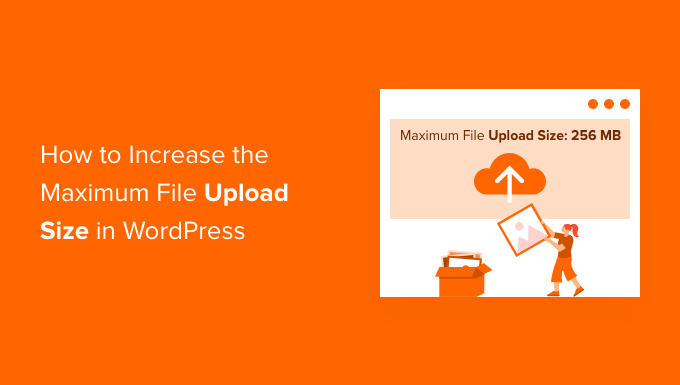
Dlaczego zwiększyć maksymalny rozmiar przesyłanych plików w WordPressie?
Twój dostawca hostingu WordPress ustawi domyślny maksymalny rozmiar przesyłanych plików podczas rejestracji i instalacji WordPress. Twój dostawca hostingu określa ten limit, który zazwyczaj wynosi od 2 MB do 500 MB.
Dla większości właścicieli stron WordPress ten limit będzie więcej niż wystarczający.
Istnieją jednak sytuacje, w których będziesz musiał podnieść ten limit, aby uniknąć błędów przesyłania.
Na przykład:
- Prowadzisz stronę fotograficzną i musisz przesyłać duże obrazy.
- Twoje portfolio projektowe lub fotograficzne zawiera duże obrazy.
- Chcesz zainstalować większy motyw lub wtyczkę WordPress.
- Chcesz sprzedawać produkty cyfrowe, takie jak e-booki, zdjęcia, filmy i inne.
- Regularnie aktualizujesz treści i dodajesz audio, zdjęcia i inne elementy, które wykraczają poza obecny limit.
Mając to na uwadze, pokażemy Ci, jak zwiększyć maksymalny rozmiar przesyłanych plików na Twojej stronie WordPress.
Uwaga: Pamiętaj, że wyświetlanie wielu dużych plików na Twojej stronie może poważnie spowolnić jej szybkość i wydajność. Dlatego zazwyczaj zalecamy nigdy nie przesyłać filmów do WordPressa.
Ponieważ większość użytkowników ma różne konfiguracje hostingu WordPress, omówimy następujące kwestie:
- Jak sprawdzić limit maksymalnego rozmiaru przesyłanych plików w WordPress
- Metoda 1: Skontaktuj się ze swoim dostawcą hostingu WordPress
- Metoda 2: Utwórz lub edytuj istniejący plik php.ini
- Metoda 3: Dodaj kod do pliku functions.php motywu WordPress
- Metoda 4: Dodaj kod do pliku .htaccess
- Method 5: Use a WordPress Plugin to Increase File Upload Size
Jak sprawdzić limit maksymalnego rozmiaru przesyłanych plików w WordPress
WordPress automatycznie wyświetli maksymalny limit rozmiaru przesyłanych plików podczas przesyłania obrazów lub innych multimediów.
Aby to sprawdzić, przejdź do Media » Dodaj nowe w panelu administracyjnym WordPress, a zobaczysz maksymalny limit rozmiaru przesyłanych plików dla swojej witryny WordPress.
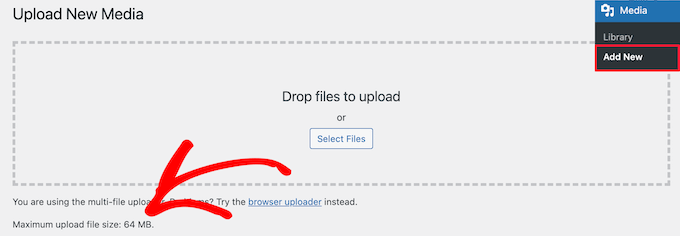
Teraz, gdy wiesz, jak znaleźć limit rozmiaru, pokażemy Ci, jak zwiększyć maksymalny rozmiar przesyłania w WordPress.
Metoda 1: Skontaktuj się ze swoim dostawcą hostingu WordPress
Jednym z najprostszych sposobów na zwiększenie maksymalnego rozmiaru przesyłanych plików w WordPressie jest skontaktowanie się z dostawcą hostingu WordPress.
Jest to stosunkowo proste zadanie dla ich zespołu ds. obsługi klienta i można je wykonać w ciągu kilku minut.
Dla początkujących może to być znacznie łatwiejsze niż dodawanie kodu do WordPressa i edycja plików serwerowych.
Po prostu przejdź na stronę swojego dostawcy hostingu, na przykład Bluehost, i zaloguj się.
Następnie kliknij ikonę „Czat” u dołu ekranu. Możesz wtedy poprosić personel wsparcia o zwiększenie rozmiaru przesyłanych plików na Twojej stronie WordPress.
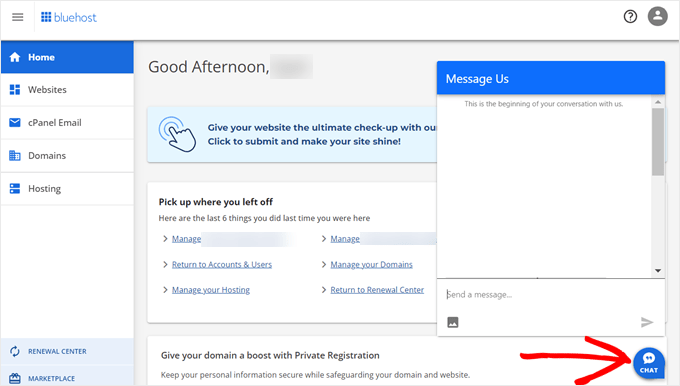
Możesz również skontaktować się z pomocą techniczną z poziomu panelu swojego konta hostingowego.
Metoda 2: Utwórz lub edytuj istniejący plik php.ini
Innym sposobem na zwiększenie maksymalnego rozmiaru przesyłanych plików jest utworzenie lub edycja pliku o nazwie php.ini. Ten plik kontroluje wiele ustawień Twojego środowiska hostingowego WordPress.
Większość dostawców hostingu WordPress, takich jak Bluehost, ma przyjazny dla początkujących cPanel do zarządzania Twoją stroną internetową.
Jeśli Twój hosting internetowy ma panel administracyjny cPanel, możesz zwiększyć rozmiar przesyłanych plików za pomocą wbudowanych narzędzi.
Uwaga: Poniższe informacje pochodzą z panelu cPanel Bluehost. Jednak większość dostawców hostingu współdzielonego będzie miała podobne kroki.
Przycisk cPanel znajdziesz na dole zakładki Hosting w Bluehost.
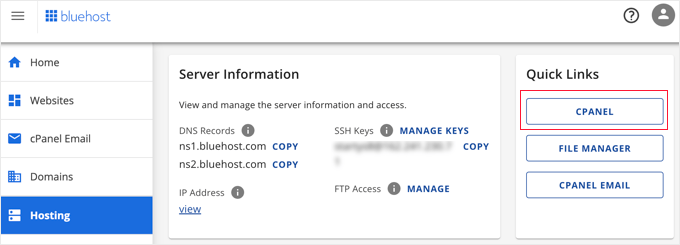
Kliknięcie tego przycisku otworzy pulpit cPanel.
Teraz musisz przewinąć w dół do sekcji Oprogramowanie i kliknąć „Edytor MultiPHP INI”.
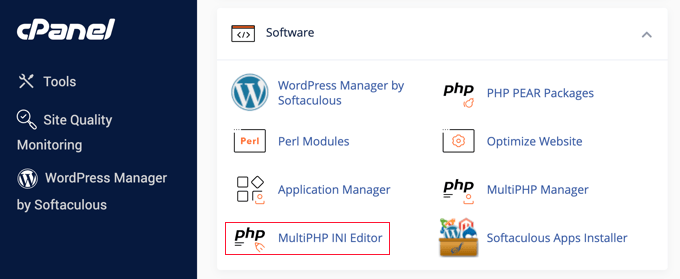
Następnie przewiń w dół do sekcji zatytułowanej „upload_max_filesize” i wprowadź nowy maksymalny rozmiar pliku w polu.
Następnie kliknij przycisk „Zastosuj”.
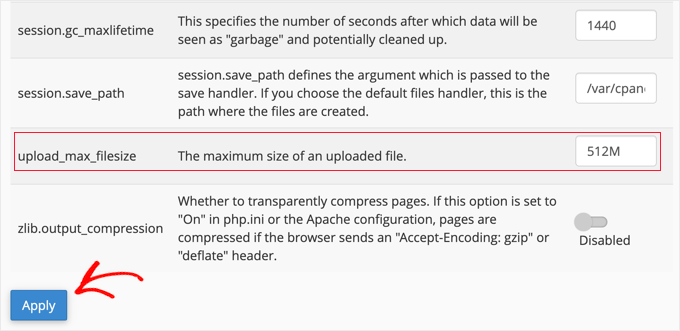
Alternatywnie, możesz kliknąć zakładkę menu „Tryb edytora”, a następnie możesz bezpośrednio zmienić maksymalny rozmiar przesyłanego pliku w edytorze.
Musisz edytować sekcję „upload_max_filesize”, aby zwiększyć rozmiar przesyłanych plików.
Po zakończeniu kliknij przycisk „Zapisz”.
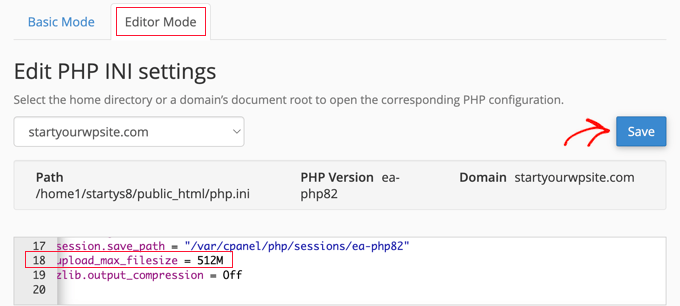
Edytuj plik php.ini, dodając kod
Jeśli Twój obecny dostawca hostingu nie oferuje opcji cPanel, będziesz musiał edytować ten plik ręcznie.
Aby to zrobić, możesz użyć klienta FTP lub opcji menedżera plików w panelu kontrolnym hostingu WordPress.
Jeśli korzystasz z hostingu współdzielonego, możesz nie widzieć pliku php.ini w swoim katalogu hostingowym. Jeśli go nie widzisz, po prostu utwórz plik o nazwie php.ini i prześlij go do swojego głównego folderu.
Następnie dodaj następnią fragment kodu do pliku:
upload_max_filesize = 256M
post_max_size = 256M
max_execution_time = 300
Możesz zmodyfikować limit „256M” do rozmiaru pliku, którego potrzebujesz dla swojego bloga WordPress.
Metoda 3: Dodaj kod do pliku functions.php motywu WordPress
Ta metoda polega na dodaniu kodu do pliku functions.php w Twoim motywie WordPress.
Zamiast edytować plik bezpośrednio, zalecamy użycie WPCode. Jest to najlepsza wtyczka fragmentów kodu, która pozwala dodawać kod do Twojej witryny bez jej psucia.
Jeśli jeszcze tego nie robiłeś, zapoznaj się z naszym przewodnikiem dla początkujących na temat jak dodawać niestandardowy kod w WordPress.
Najpierw musisz zainstalować bezpłatny wtyczkę WPCode. Więcej szczegółów znajdziesz w naszym przewodniku krok po kroku na temat jak zainstalować wtyczkę WordPress.
Po aktywacji przejdź do Code Snippets » + Add Snippet.
Musisz najechać kursorem myszy na opcję „Dodaj swój niestandardowy kod (nowy fragment)” i kliknąć przycisk „+ Dodaj niestandardowy fragment”.

Następnie musisz wybrać „Fragment PHP” jako typ kodu z wyświetlonej listy opcji.
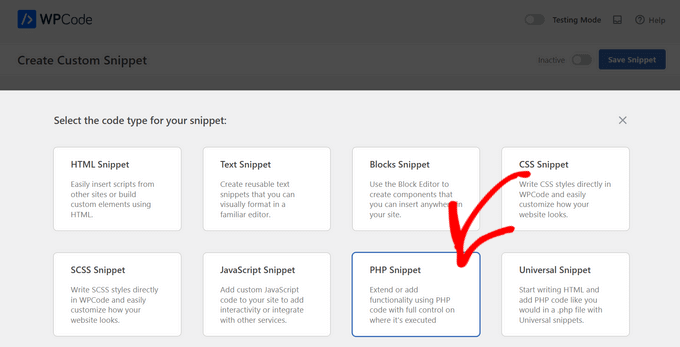
Na następnym ekranie wprowadź nazwę dla swojego nowego fragmentu kodu, która może być dowolna, aby pomóc Ci zapamiętać, do czego służy kod.
Następnie możesz skopiować i wkleić poniższy fragment kodu pod sekcją „Podgląd kodu”. Upewnij się, że zmienisz „256M” na maksymalny rozmiar pliku, którego potrzebujesz:
@ini_set( 'upload_max_size' , '256M' );
@ini_set( 'post_max_size', '256M');
@ini_set( 'max_execution_time', '300' );
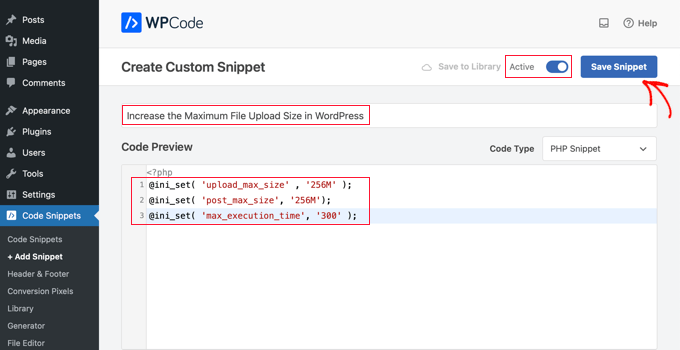
Na koniec przełącz przełącznik u góry na „Aktywny”, a następnie kliknij przycisk „Zapisz fragment”. Kod zostanie teraz wykonany na Twojej stronie internetowej.
Metoda 4: Dodaj kod do pliku .htaccess
Innym sposobem na zwiększenie maksymalnego rozmiaru plików jest modyfikacja pliku .htaccess. Ten plik kontroluje ustawienia konfiguracji wysokiego poziomu Twojej witryny.
Aby to zrobić, musisz zalogować się na serwer swojej witryny przez FTP. Jeśli nigdy tego nie robiłeś, zapoznaj się z naszym przewodnikiem jak używać FTP do przesyłania plików do WordPressa dla początkujących.
Następnie musisz zlokalizować plik .htaccess w głównym folderze swojej witryny.

Jeśli nie możesz znaleźć pliku .htaccess, może on być ukryty przez menedżera plików lub klienta FTP. Aby dowiedzieć się więcej, zapoznaj się z naszym przewodnikiem dlaczego nie możesz znaleźć pliku .htaccess na swojej stronie WordPress.
Następnie musisz dodać następujący fragment kodu do swojego pliku .htaccess:
php_value upload_max_filesize 256M
php_value post_max_size 256M
php_value max_execution_time 300
php_value max_input_time 300
Aby jeszcze bardziej zwiększyć maksymalny rozmiar przesyłanych plików, po prostu zmień „64M” na wymagany rozmiar.
Metoda 5: Użyj wtyczki WordPress do zwiększenia rozmiaru przesyłanych plików
Innym sposobem na zwiększenie maksymalnego limitu przesyłania plików jest użycie wtyczki WP Increase Upload Filesize. Jeśli nie czujesz się komfortowo z dodawaniem kodu do WordPress, może to być dla Ciebie dobra opcja.
Pierwszą rzeczą, którą musisz zrobić, to zainstalować i aktywować wtyczkę. Więcej szczegółów znajdziesz w naszym przewodniku jak zainstalować wtyczkę WordPress.
Po aktywacji przejdź do Media » Zwiększ limit przesyłania w swoim panelu administracyjnym WordPress.
Spowoduje to przejście do ekranu, na którym można wybrać nowy rozmiar przesyłanego pliku z listy rozwijanej „Wybierz maksymalny rozmiar przesyłanego pliku”.
Następnie kliknij przycisk „Zapisz zmiany”.

Uwaga: Maksymalny rozmiar przesyłanego pliku zostanie ustawiony przez Twojego dostawcę hostingu. Jeśli potrzebujesz limitu rozmiaru pliku większego niż ten wymieniony na liście rozwijanej, musisz skontaktować się ze swoim dostawcą hostingu i poprosić o zwiększenie limitu.
Samouczek wideo
Jeśli nie lubisz postępować zgodnie z pisemnymi instrukcjami, możesz zamiast tego obejrzeć nasz samouczek wideo:
Mamy nadzieję, że ten artykuł pomógł Ci zwiększyć maksymalny rozmiar przesyłanych plików w WordPress. Możesz również zapoznać się z naszym przewodnikiem na temat jak dodawać dodatkowe typy plików do przesyłania w WordPress oraz naszymi ekskluzywnymi wyborami wtyczek i wskazówek dotyczących ulepszenia obszaru administracyjnego WordPress.
Jeśli podobał Ci się ten artykuł, zasubskrybuj nasz kanał YouTube po samouczki wideo WordPress. Możesz nas również znaleźć na Twitterze i Facebooku.





Sushil Kumar
Dziękuję Yasir Imran, działa dla mnie przez .htaccess
Pedro Viana
Reguły .htaccess! dzięki.
Amit Kumar Gupta
Bardzo przydatny artykuł dla mnie. Dziękuję wpbeginner
Steve S
Wymyśliłem obejście, które nie wymaga modyfikowania php.ini, .htaccess, functions.php ani żadnych innych plików systemowych. Zrobiłem tylko następujące czynności:
* Prześlij plik przez FTP do /wp-content/uploads/rok/miesiąc/nazwa_pliku.mp4
* Nowy Post –> Dodaj Media –> Wstaw z adresu URL
* Wytnij i wklej odpowiedni adres URL w zależności od miejsca, w którym przesłałeś plik.
* Kliknij Wstaw do Postu. Gotowe.
kenny
Doskonale! ps jeśli wstawiasz obraz jako tło slajdu w Slider Revolution, użyj opcji „Zewnętrzny adres URL”
vic
plik .htaccess zadziałał u mnie bez problemu. dzięki wielkie
Anchal Singh
moja strona internetowa miała ten sam problem, ale dzięki temu postowi działa teraz idealnie
Matt
Dzięki. Chciałbym również wiedzieć, jak stworzyć portal internetowy za pomocą WordPressa. Będę bardzo wdzięczny za wszelkie informacje od Ciebie.
marta
Thanks. For me htaccess Method did his job
Rifqi Arief
Dzięki Bracie, działa na moim darmowym hostingu przez .htacess
RT
Proszę spróbuj poniższych kroków również po utworzeniu pliku php.ini
(1) Przejdź do Moje witryny -> Administracja sieci -> Ustawienia z panelu administracyjnego WordPress.
Odznacz pole wyboru „Miejsce na przesłane pliki: Ogranicz całkowity rozmiar przesłanych plików do 10 MB” i zapisz zmiany.
(3) Zrobione.
Pozdrawiam,
-RT
Suika
Dzięki, zapomniałem, że tam było takie ustawienie.
Abhishek
Jestem na hostingu goddady, żadne z 3 rozwiązań mi nie zadziałało.
Ale niektórzy użytkownicy zgłosili, że plik .user.ini zadziałał im na godaddy.
Czy ktoś może mi powiedzieć, gdzie umieścić ten plik?
Próbowałem w folderze głównym i folderze wp-admin, nic nie zadziałało.
Raman Gutyan
Metoda htaccess działa świetnie na moim lokalnym serwerze.
Dzięki za udostępnienie.
DVR
Jeśli napotykasz problemy. Przejdź do swojego hostingu. Zaawansowane ustawienia PHP. Przeskanuj kod w poszukiwaniu "max upload" i "file size". Zmień na wymagane ustawienie.
Zrobione.
Zobacz odpowiedź NICOLASA powyżej.
martin kendall
Cześć DVR, próbowałem wszystkiego i nic nie działało, zgodnie z tym, co zostało tutaj opublikowane. Próbowałem wielokrotnie na każdy sposób, żeby to zadziałało. Nic, ale Twój post naprowadził mnie na właściwą odpowiedź. Bardzo za to dziękuję.
Ok, oto co zrobiłem, zalogowałem się na mój serwer hostingowy, gdzie znajduje się moja strona internetowa. Serwer hostingowy działa na cPanelu, a motyw to paper_lantern. Nie powinno mieć znaczenia, jaki jest Twój serwer ani motyw. Jeśli nie masz dostępu do tego obszaru, będziesz musiał poprosić swojego hosta o wprowadzenie zmian, kontaktując się z pomocą techniczną.
W panelu znajdziesz kategorie takie jak = pliki, bazy danych, domeny, e-mail itp., a to, czego szukasz, to oprogramowanie, w sekcji oprogramowanie / aplikacje poszukaj edytora multiPHP INI lub czegoś podobnego. Na innych platformach będzie to wyglądać inaczej, ale powinno być w tym obszarze. Szukasz konfiguracji podstawowych ustawień PHP INI lub trybu edytora. Zaoferowano mi katalog główny lub nazwę mojej domeny. Wybrałem nazwę domeny, ale być może trzeba zmienić oba, ale nie musiałem. Przewinąłem w dół do upload_max_filesize i zmieniłem na 64M, ale to nie zadziałało, ponieważ trzeba również zmienić memory_limit na 64M. Muszą być takie same. i wtedy zadziała.
Jak rozumiem, kiedy wprowadzasz zmiany w kodzie WordPressa, instrukcje rozmawiają z Twoją bazą danych za pośrednictwem plików PHP i instruują oprogramowanie serwerowe, aby zmieniło ustawienia bazy danych. Z jakiegoś powodu u mnie to nie działało. Więc ta ścieżka omija to i wprowadza zmiany w oprogramowaniu serwerowym, a nie w oprogramowaniu WordPress. W przyszłości pójdę tą drogą, ponieważ było to naprawdę szybkie. Mam nadzieję, że to pomoże jako ostateczność. Martin p.s. był to Wordpress 4.8.1 i odkryłem, że po jego załadowaniu nie miał żadnych plików PHP.INI ani .htaccess. Zainstalowałem je, ale nie miało to żadnego znaczenia ani nie wiedziałem, gdzie je umieścić.
Jeet Patel
THank you so much it’s working really
Silentnight
Dziękuję bardzo… Zwiększyłem rozmiar przesyłania.
Gopi krishnan
Dla mnie to nie działa, ale zrobiłem to w pliku htaccess w ten sposób,
php_value post_max_size 10M
php_value upload_max_filesize 40M
php_value memory_limit 500M
To działa!
agnieszka00
Dziękuję!!!!!
Michael Serovey
Mam swoje strony internetowe hostowane u GoDaddy i do tej pory ŻADNA z powyższych sugestii nie zadziałała! Zapłaciłem za ten wtyczkę i teraz zmarnowałem pieniądze!
Paul
Cześć,
Aby ominąć limit przesyłania wtyczek, możesz po prostu przesłać wtyczkę za pomocą FileZilla do swojego katalogu wtyczek. Po przesłaniu możesz rozpakować plik zip w menedżerze plików, a po wykonaniu tej czynności wtyczka będzie widoczna i gotowa do aktywacji w panelu administratora –> wtyczki
Mam nadzieję, że to pomogło.
Pozdrawiam
Pooya
WOW! DZIĘKI PAUL!!
To zadziałało idealnie dla mnie!
i jest to DUŻO łatwiejsze i bardziej niezawodne niż którakolwiek z tych metod.
przejdź do Katalogu plików w cPanel -> Public-html -> [ folder Twojej witryny] -> wp-content ->themes lub plugins
Następnie prześlij plik zip tutaj i rozpakuj go.
zaloguj się do swojego panelu administracyjnego wp-admin. i bam, masz motyw lub wtyczkę.
Tom
Chwała Bogu (paul), zajęło to zbyt długo.
Nicolas
Po prostu przejdź do panelu hostingowego -> Zaawansowane -> Ustawienia PHP -> upload_max_filesize (zazwyczaj jest ustawione na 2M, możesz zmienić je do 8M w moim przypadku... chodzi o to, że nie powinno być wyższe niż post_max_size)
Nie ma za co!
Jake
Najlepsza odpowiedź do tej pory.
Steven Gliebe
functions.php nie jest najlepszym miejscem na umieszczenie kodu, ponieważ zwiększenie limitu maksymalnego rozmiaru przesyłania PHP nie jest związane z konkretnym motywem. Użytkownicy i tak nie powinni zmieniać plików motywu bezpośrednio. wp-config.php jest prawdopodobnie lepszym miejscem. Metoda .htaccess lub php.ini jest jeszcze lepsza (lub po prostu zapytaj hosta).
Stephanie
php.ini musi znajdować się w folderze wp-admin. Ten artykuł podaje, że musi znajdować się w katalogu głównym, co próbowałem, ale nie przyniosło to żadnej różnicy. FYI
Dziękuję za informację!
Aaron
Bardzo dziękuję za odpowiedź Stephanie. Twoje informacje były dokładnie tym, czego potrzebowałam.
Mike Serovey
Do tej pory ŻADNA z powyższych sugestii nie zadziałała. Mój panel sterowania NIE pozwala mi na zmianę Ustawień PHP, modyfikacja .htaccess spowodowała błąd wewnętrzny serwera, a modyfikacja motywu również nie zadziałała. Czy masz jakieś inne sugestie?
Mike Serovey
Korzystając z hostingu GoDaddy, odkryłem, że musiałem użyć linii kodu, które ktoś opublikował dla pliku .user.ini, a następnie odświeżyć przeglądarkę i sprawdzić wtyczkę około trzech razy, zanim w końcu zadziałało!
Robert
Dziękuję! Plik ini należy przesłać do folderu wp-admin.
Emmanuel Parbey
Dziękuję.
Działało idealnie.
Somnath
@Stephnie Dzięki wielkie. Działa
Sorin
W wp-admin umieść php.ini i działa
Angel Rodriguez
To również zadziałało dla mnie.
shemmy
dzięki .. to działa dobrze
Prabhat
tak, to jest pomocne
Matt
Zadziałało natychmiast! Dzięki! Swoją drogą, jeśli ktoś inny chce wiedzieć, mój hosting to BlueHost i używam motywu Genesis.
Panagiotis Sakalakis
Używając .htaccess otrzymałem błąd wewnętrzny, a następnie po prostu usunąłem kod i problem został rozwiązany. Po tym utworzyłem plik php.ini w /public_html/wp-admin, wkleiłem kod i zapisałem go. Wszystko działa teraz jak marzenie i mogę bez problemu przesyłać moje pliki.
Umesh Shejole
Tak, przydatne……
Subin Babukuttan
htaccess działał dobrze. Dzięki za post
hol
Cześć
Czy ktoś wie, dlaczego, jeśli plik PHP.INI zostanie zmieniony zgodnie z opisem, po zakończeniu pliku do 100% nic się nie dzieje i wyświetla się błąd http?
Mogę przesyłać małe pliki i krótkie filmy.
Nie mogę przesyłać niczego większego niż powiedzmy 200 MB
Miałem to działające i akceptujące większe pliki, a potem miałem przywrócenie strony internetowej.
Zmieniłem PHP.INI...
Czy jest jakiś powód, dla którego działają tylko duże pliki?
Czy muszę edytować plik hta.access?
dzięki
Ian
Metoda .htaccess działała na hostingu Media Temple grid, inne nie miały na nią wpływu, na wypadek gdyby ktoś się zastanawiał...
Jay
JEŚLI NADAL NIC NIE DZIAŁA..
(W moim przypadku problem dotyczył WP MULTISITES)..,
NAJPIERW SPRAWDŹ NASTĘPUJĄCE:
1. Sprawdź limity swojego hostingu (chociaż to nie był mój problem) upewnij się, że Twój hosting pozwala na ustawienie limitu, który próbujesz ustawić, np. na hostingu współdzielonym możesz znaleźć maksymalnie 64 MB.
UWAGA: Poniższe rozwiązanie może mieć również zastosowanie, jeśli w WordPressie maksymalny rozmiar przesyłanego pliku nie zmieni się nawet po zmianie w pliku php.ini itp.
Problem z maksymalnym rozmiarem przesłania 1 MB leży w domyślnych ustawieniach WP MULTISITES!!
Aby to zmienić, wykonaj poniższe czynności, aby zmienić maksymalny rozmiar przesyłanego pliku w panelu WP:
ZALOGUJ SIĘ DO SWOJEGO PANELU ADMINISTRACYJNEGO:
1. Na górze najedź kursorem na Moje strony, a następnie kliknij Administracja siecią.
2. Po lewej najedź kursorem na Ustawienia, a następnie kliknij Ustawienia sieci.
3. Przewiń stronę do dołu i zmień Maksymalny rozmiar pliku do przesłania na dowolny, jaki chcesz w KB.
4. Kliknij Zapisz zmiany.
Hope this helps
Gregg
TAKKK. Dziękuję panu.
Milton
Dzięki Jay, trafiłeś w sedno w przypadku multisite WordPress
Denis
Zadziałało u mnie. Witryna działała wcześniej i nie mogłem zrozumieć, dlaczego już nie działa. To była moja konwersja na multisite, która spowodowała problem.
Sam
Niesamowite!!! Działa!
Adam
Dzięki!!!! Jezu, niewiele jest pomocy dotyczącej zmian wprowadzanych przez multisite!
Bhanu uday
Działało jak marzenie. Bardzo dziękuję.
AmanDeep Singh
Działa !. Użyłem metody Utwórz lub edytuj istniejący plik PHP.INI, a po zastosowaniu ustawień opisanych w artykule mogę teraz przesyłać motywy i wtyczki, które są duże. Dziękuję za udostępnienie rozwiązania.
Judy
Jestem nowy w WordPress, zwykle używam Joomla, ale mam nowego klienta, który chce stronę WordPress. Podczas próby przesłania obrazów komunikat WordPress brzmiał, że limit pliku wynosi 3 MB. Spędziłem godziny na przeszukiwaniu stron internetowych w poszukiwaniu odpowiedzi. Używam WAMP i localhost do tworzenia strony. Poprzez localhost phpinfo() mogłem zweryfikować, który plik php.ini jest aktywny, ten w Apache. Miałem limit pliku 64 MB, ale WordPress nadal miał limit 3 MB. Ta strona zawierała instrukcje pod #3, aby edytować plik .htaccess w folderze WordPress. Skopiowałem i wkleiłem tekst do tego pliku i DZIAŁAŁO! Dziękuję wpbeginner.
KenSanDiego
zapomniałem dodać, moja strona WP znajduje się w podkatalogu z wskaźnikiem domeny. php Powweb dotyczy wszystkiego we wszystkich podkatalogach. Więc jeśli masz jakieś instalacje w podkatalogach, zmiana dotyczy wszystkich instalacji.
Ugyen Zangmo
Utwórz plik php.ini w folderze wp-admin
W pliku umieść następujące 3 linie:
upload_max_filesize = 2048M
post_max_size = 2048M
max_execution_time = 3000
Przejdź do swojej strony internetowej jako administrator i sprawdź stronę przesyłania nowych multimediów, powinna teraz wyświetlać Maksymalny rozmiar przesyłanego pliku: 2 GB.
Podziękowania dla Yasira Imrana za podzielenie się swoją wskazówką!
To zadziałało u mnie. Dziękuję James za podzielenie się wskazówką Yasira Imrana. Pozdrawiam
sadiq
nie działa zrobiłem to samo
na serwerze godaddy
Raton Miah
działa!
Brendan
To była świetna wskazówka… zadziałała u mnie.. dzięki!
Ben
Święta racja! Dzięki wielkie, po ostatniej aktualizacji WordPressa do wersji 4.3.1 mój rozmiar wysyłania powrócił do domyślnych 50 MB, mimo że moje pliki php.ini, .htaccess i wp-config.php nie uległy zmianie i nadal odzwierciedlały maksymalny rozmiar wysyłania 512 MB! Jesteś bohaterem!
Alain
Dziękuję bardzo!
Próbowałem WSZYSTKICH trzech metod bez rezultatów.
Zapytałem dostawcę hostingu i podnieśli limit do 40 MB.
Potem w końcu wypróbowałem Twoją i zadziałało fantastycznie!
dominio público
post_max_size powinien być większy niż upload_max_filesize, aby zapewnić miejsce na inne informacje. Domyślnie maksymalny rozmiar pliku to 2 MB, a maksymalny rozmiar posta to 8 MB.
Z dokumentacji PHP:
post_max_size integer
Określa maksymalny rozmiar danych POST, który jest dozwolony. To ustawienie wpływa również na przesyłanie plików. Aby przesyłać duże pliki, ta wartość musi być większa niż upload_max_filesize.
Nori
Dzięki za to! Wypróbowałem php.ini i jestem dość zaskoczony, że zadziałało i było tak łatwe
Dan
Plik php.ini zadziałał dla mnie idealnie. Po prostu zmieniłem istniejące wartości na 100M. Wszystko w porządku. Dzięki za radę.
James
Utwórz plik php.ini w folderze wp-admin
W pliku umieść następujące 3 linie:
upload_max_filesize = 2048M
post_max_size = 2048M
max_execution_time = 3000
Przejdź do swojej strony internetowej jako administrator i sprawdź stronę przesyłania nowych multimediów, powinna teraz wyświetlać Maksymalny rozmiar przesyłanego pliku: 2 GB.
Podziękowania dla Yasira Imrana za podzielenie się swoją wskazówką!
Zain
Cześć,
Proszę, podaj mi nazwy najlepszych motywów dla stron z oprogramowaniem/pobraniami?
Czekam.
Dzięki,
Zain.
Markus Aurelius
Nic z powyższych nie zadziałało u mnie na GoDaddy, więc musiałem użyć .user.ini zamiast php.ini i to zadziałało bez problemu. Dzięki za wskazanie właściwego kierunku!
Keith
Bardzo dziękuję. Jestem na GoDaddy i to zadziałało, podczas gdy wiele innych metod nie.
Raj Kothari
Cześć Keith, czy możesz mi powiedzieć, w jakim folderze umieściłeś ten plik? .user.ini
Potrzebuję pomocy
Oliver
Dzięki, .user.ini zadziałało u mnie na Godaddy
sam
1:- otwórz folder „C:wampbinapacheapache2.4.9bin” i znajdź „php”, który jest plikiem konfiguracyjnym, otwórz go w notatniku i ponownie znajdź „upload_max_filesize” i „post_max_size” i zmień oba, a następnie zapisz.
2:- otwórz folder „C:wampbinphpphp5.5.12” i znajdź „php” i „phpforapache”, które są plikami konfiguracyjnymi, otwórz oba w notatniku i ponownie znajdź „upload_max_filesize” i „post_max_size” i zmień oba i zapisz.
3:- na koniec zrestartuj wszystkie usługi wamp i ciesz się… kocham was wszystkich
Decb
Cześć, jestem BARDZO nowy w tym, ale czy możecie spojrzeć na to, co widzę, gdy klikam, aby edytować plik .htaccess – gdzie mam dodać kod? na początku? na końcu? Czy mam postawić kursor na początku i nacisnąć Enter (a potem wstawić)? ??? Pomóżcie proszę
Gerard ONeill
Deb, nie miałoby znaczenia, gdzie to dodasz; ale upewnij się, że jest to poza blokiem. Dla bezpieczeństwa dodaj to na końcu.
Jednak lepszym sposobem (od wersji php5.5) jest modyfikacja pliku .user.ini dla każdego katalogu z osobna. Jeśli zmodyfikowałbyś katalog główny, zastosowałoby się to do wszystkich podkatalogów (chyba że zostanie nadpisane).
http://php.net/manual/en/configuration.file.per-user.php
I oczywiście systemowy plik php.ini też działa.
BenPDX
+1 dla rozwiązania Alexa. Wgranie folderu php.ini do folderu wp-admin zadziałało u mnie na Lithium Hosting. 30 sekund szukania w Google i 1 minuta na stworzenie pliku tekstowego i wgranie go na serwer!
Dede Erik
Wybrałem trzecią metodę i zadziałała u mnie, bardzo dziękuję
Hasan Tareq
.htaccess działa dla mojej strony wpenigne
Vineesh
Cześć Alex, masz rację. Plik php.ini powinien zostać dodany do folderu wp-admin. Będzie działać idealnie... dzięki Alex
Rafael
Samo dodanie pliku php.ini do folderu wp admin zadziałało idealnie!!! dzięki!
chandan
thnx alot Alex this worked for me to..
Tony_atf
Ciągle otrzymuję błąd http, nawet z twoją sugestią. Jestem na godaddy, mam rozmiar pliku 300 MB, ale wszystko powyżej 150 MB się zacina. Przesyła się, czeka kilka sekund, a następnie wyświetla się błąd http. WordPress nigdy nie pokazuje błędu.
SunnyK
ze mną to samo. czy znalazłeś już jakieś rozwiązanie?
Zespół WPBeginner
Możesz połączyć się ze swoją stroną internetową za pomocą klienta FTP i cofnąć wprowadzone zmiany.
Nitesh Magan
Hej, dodałem pierwszy kod do pliku funkcji mojego motywu, ale teraz wszystko na mojej stronie stało się puste. Nie mogę nawet uzyskać dostępu do mojego wp-admin mojej strony!!
Proszę o pomoc…
Chris
Jeśli po prostu próbujesz samodzielnie przesłać pliki w panelu administracyjnym (media), utwórz nowy zwykły plik tekstowy, zapisz go pod dowolną nazwą (w tym rozszerzeniem) dużego pliku, który próbujesz przesłać. Więc jeśli próbujesz przesłać „files.zip”, zapisz pusty plik tekstowy jako files.zip. Prześlij ten pusty plik tekstowy, który właśnie utworzyłeś w WordPressie. Następnie przejdź do FTP lub menedżera plików, przejdź do wp-content/uploads/(jaki to rok)/(jaki to miesiąc). Powinieneś tam znaleźć files.zip. Usuń ten plik (który jest tylko zwykłym plikiem tekstowym), a następnie prześlij prawdziwy plik files.zip, upewniając się, że nazwy się zgadzają. Następnie, gdy wrócisz do mediów, będzie to właściwy plik.
Yasir Imran
Wypróbowałem metodę htaccess i otrzymałem błąd serwera 500, następnie umieściłem php.ini z 3 podanymi liniami w katalogu głównym, ponownie nie zadziałało. Następnie umieściłem go w folderze wp-admin i zadziałało. Myślę, że autor powinien o tym wspomnieć.
Alexandre
To zadziałało u mnie, podczas gdy wszystko inne zawiodło. Dziękuję za udostępnienie.
Mel
Miałem dokładnie takie samo doświadczenie i to zadziałało dla mnie. Dzięki Yasir!
Les B
Dziękuję Yasir Imran… Twoja metoda działa tam, gdzie wszystkie inne, w tym .htaccess, zawodzą!
(Plik php.ini musi znajdować się w folderze wp-admin.)
Les